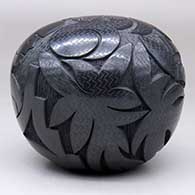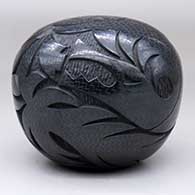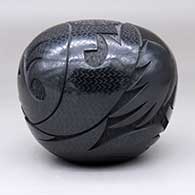
Click or tap to see a larger version
Lucy Year Flower, Pojoaque, A black seed pot decorated with a carved and sgraffito woman, avanyu, leaf and geometric design
Pojoaque
$ 550
shsc4f619
A black seed pot decorated with a carved and sgraffito woman, avanyu, leaf and geometric design
4.75 in L by 4.75 in W by 4.25 in H
Condition: Very good
Signature: Lucy Year Flower Pojoaque and Santa Clara
Tell me more! Buy this piece!
(505) 986-1234 - www.andreafisherpottery.com - All Rights Reserved
Pojoaque Pueblo
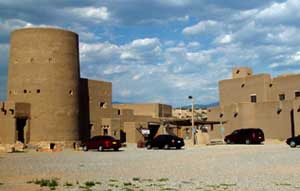
Poeh Culture Center at Pojoaque
The Pojoaque Pueblo area seems to have been first settled by pithouse-dwelling Tanoans around 500 CE. A couple hundred years later and the first signs of pottery appeared. Another couple hundred years and the people were beginning to build their structures aboveground. The Tewa flooded down into the valley of the Rio Grande starting in the 1300s, and the population grew until it peaked in the late 1500s. That peak was around the same time the first Spanish arrived. After that, local populations nose-dived as European diseases and Franciscan monks wreaked collossal damage, to the point of actual genocide in some cases (none of the Piro pueblos survived after the 1680 Pueblo Revolt and none of the Tompiro pueblos survived the mid-1700s).
The first Franciscan mission was built at Pojoaque in the early 1600s but the people were already hurting under the impact of Spanish taxes, forced labor and continuous efforts to force conversion to Christianity. That all added up to Pojoaque being in the forefront of the Pueblo Revolt of 1680. Immediately following the revolt, Pojoaque was abandoned and wasn't resettled until about 1706 when many Pojoaque's trickled back from the Cuartelejo area on the plains of eastern Colorado and western Kansas. By then the major Spanish retributions had died down and it was relatively safe to return, surrender and pledge allegiance anew. Franciscans were also being replaced with Jesuits and the religious fervor receded a bit from the heights reached during the Inquisition.
The population of the reestablished pueblo grew slowly but they saw increasing problems from non-Indian encroachment until President Abraham Lincoln recognized the pueblo as an official tribe. Some documents say he awarded the tribe with an official land grant in 1864 and gave a silver cane to the tribe's governor. Other documents say the tribe was given a quit-claim deed... However it worked out, the tribe did gain some legal standing and was able to reestablish its presence until 1900 when a severe smallpox epidemic caused the pueblo to be abandoned again (the Cacique (the tribe's religious leader) died and Governor Jose Antonio Tapia left the reservation to find work).
In 1934 the Commissioner of Indian Affairs placed newspaper ads around the area calling for all Pojoaque tribal members to come back and reoccupy the pueblo lands or tribal ownership would be dissolved under the Indian Re-Organization Act. Shortly, 14 members of the Villareal, Tapia, Romero and Gutierrez/Montoya families were awarded land grants from the Pueblo land base. By 1936 tribal enrollment reached 263 members and Pojoaque became a Federally recognized Indian Reservation.
During the time of abandonment, many Pojoaque tribe members moved to nearby Santa Clara and San Juan Pueblos. Those Pojoaque who were making pottery at the time learned new things from their neighbors and when they later returned to Pojoaque, traditional pottery making changed with all the cross-pollination of styles and designs. Some potters, though, returned to making only traditional Pojoaque styles and designs. Today there is hardly any pottery being made at Pojoaque as so many tribal members are employed in one or another of the tribe's many commercial enterprises.
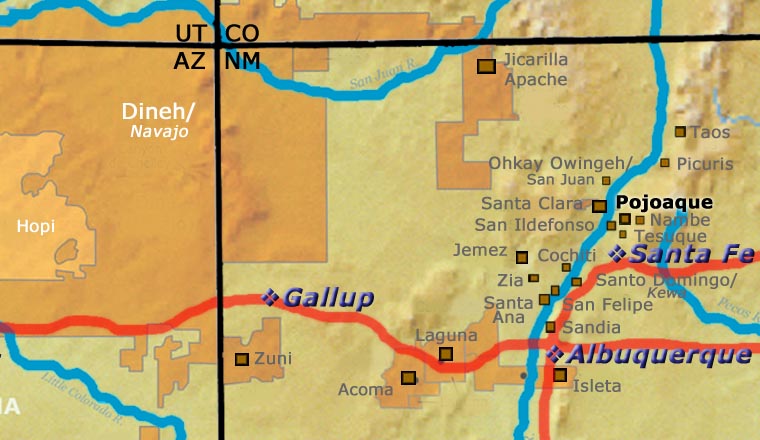
Pojoaque Pueblo at Wikipedia
Pueblo of Pojoaque official website
Office of the New Mexico State Historian
Seed Pots
Acoma, Hopi, Isleta, Jemez, Laguna, San Felipe, San Ildefonso, San Juan, Santa Clara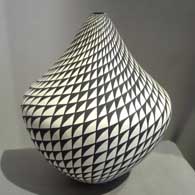
Acoma Pueblo
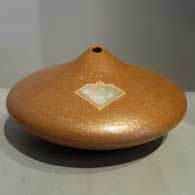
Hopi
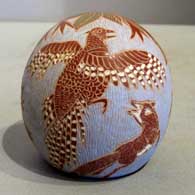
Santa Clara Pueblo
It was a matter of survival to the ancient Native American people that seeds be stored properly until the next planting season. Small, hollow pots were made to ensure that the precious seeds would be kept safe from moisture, light and rodents. After seeds were put into the pot, the small hole in the pot was plugged. The following spring the plug was removed and the seeds were shaken from the pot directly onto the planting area.
Today, seed pots are no longer necessary due to readily available seeds from commercial suppliers. However, seed pots continue to be made as beautiful, decorative works of art. The sizes and shapes of seed pots have evolved and vary greatly, depending on the vision of Clay Mother as seen through the artist. The decorations vary, too, from simple white seed pots with raised relief to multi-colored painted, raised relief and sgraffito designs, sometimes with inlaid gemstones and silver lids.
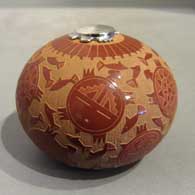
Santa Clara Pueblo
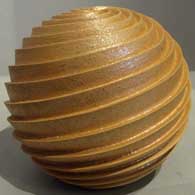
Jemez Pueblo
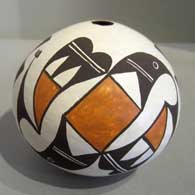
Acoma Pueblo
Margaret Tafoya Family Tree
Disclaimer: This "family tree" is a best effort on our part to determine who the potters are in this family and arrange them in a generational order. The general information available is questionable so we have tried to show each of these diagrams to living members of each family to get their input and approval, too. This diagram is subject to change should we get better info.
Note: Sarafina (Gutierrez) Tafoya was the sister of Pasqualita Tani Gutierrez.
- Sarafina Tafoya (1863-1949) & Geronimo Tafoya
- Margaret Tafoya (1904-2001) & Alcario Tafoya (d. 1995)
- Mary Ester Archuleta (1942-2010)
- Barry Archuleta
- Bryon Archuleta
- Sheila Archuleta
- Jennie Trammel (1929-2010)
- Karen Trammel Beloris
- Virginia Ebelacker (1925-2001)
- James Ebelacker (1960-) & Cynthia Ebelacker
- Jamelyn Ebelacker
- Sarena Ebelacker
- Richard Ebelacker (1946-2010) & Yvonne Ortiz
- Jason Ebelacker
- Jerome Ebelacker & Dyan Esquibel
- Andrew Ebelacker
- Nickolas Ebelacker
- James Ebelacker (1960-) & Cynthia Ebelacker
- Lee Tafoya (1926-1996) & Betty Tafoya (Anglo)
- Linda Tafoya (Oyenque)(Sanchez) (1962-)
- Antonio Jose Oyenque
- Jeremy Rio Oyenque
- Maria Theresa Oyenque
- Melvin Tafoya
- Phyllis Bustos Tafoya
- Linda Tafoya (Oyenque)(Sanchez) (1962-)
- Mela Youngblood (1931-1990) & Walt Youngblood
- Nancy Youngblood (1955-)
- Christopher Cutler
- Joseph Lugo
- Sergio Lugo
- Nathan Youngblood (1954-)
- Nancy Youngblood (1955-)
- Toni Roller (1935-)
- Brandon Roller
- Cliff Roller (1961-)
- Deborah Morning Star Roller
- Jeff Roller (1963-)
- Jordan Roller
- Ryan Roller
- Susan Roller Whittington (1955-)
- Charles Lewis
- Tim Roller (1959-) & Clarissa Tafoya
- William Roller
- LuAnn Tafoya (1938-) & Sostence Tapia
- Michele Tapia Browning (1960-2025)
- Ashley Browning
- Mindy Browning
- Daryl Duane Whitegeese (1964-) & Rosemary Hardy
- Samantha Whitegeese
- Tina Whitegeese
- Michele Tapia Browning (1960-2025)
- Shirley Cactus Blossom Tafoya (1947-)
- Meldon Tafoya
- Andrea Tafoya
- Crystal Tafoya
- Melissa Tafoya
- Mary Ester Archuleta (1942-2010)
- Christina Naranjo (1891-1980) & Jose Victor Naranjo (1895-1942)
- Mary Cain (1916-2010)
- Billy Cain (1950-2005)
- Joy Cain (1947-)
- Linda Cain (1949-)
- Autumn Borts-Medlock (1967-)
- Tammy Garcia (1969-)
- Douglas Tafoya
- Marjorie Tafoya Tanin
- Teresita Naranjo (1919-1999)
- Stella Chavarria (1939-)
- Denise Chavarria (1959-)
- Joey Chavarria (1964-1987)
- Sunday Chavarria (1963-)
- Stella Chavarria (1939-)
- Cecilia Naranjo
- Sharon Naranjo Garcia (1951-)
- Judy Tafoya (1962-) & Lincoln Tafoya (1954-)
- Mida Tafoya (1931-2024)
- Sherry Tafoya (1956-)
- Phyllis Tafoya (1955-)
- Robert Tafoya
- Ethel Vigil
- Kimberly Garcia
- Mary Cain (1916-2010)
- Camilio Tafoya (1902-1995) & Agapita Silva (1904-1959)
- Joe Tafoya & Lucy Year Flower (1935-2012)
- Kelli Little Kachina (1967-2014)
- Myra Little Snow (1962-)
- Forrest Red Cloud Tafoya
- Shawn Tafoya (1968-)
- Joseph Lonewolf (1932-2014) & Katheryn Lonewolf
- Greg Lonewolf (1952-)
- Rosemary Apple Blossom Lonewolf (1954-) & Paul Speckled Rock (1952-2017)
- Adam Speckled Rock
- Susan Romero
- Grace Medicine Flower (1938-)
- Joe Tafoya & Lucy Year Flower (1935-2012)
- Dolorita Padilla (1897-1960) & Alberto Padilla (1898-)
- Tomacita Tafoya Naranjo (1884-1918) & Agapita Naranjo
- Nicolasa Naranjo (c.1910-) & Jose G. Tafoya
- Howard Naranjo & Linda Naranjo
- Nicolasa Naranjo (c.1910-) & Jose G. Tafoya
Some of the above info is drawn from Pueblo Indian Pottery, 750 Artist Biographies, by Gregory Schaaf, © 2000, Center for Indigenous Arts & Studies
Other info is derived from personal contacts with family members and through interminable searches of the Internet.
Copyright © 1998-2025 by

